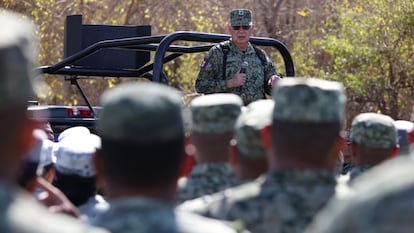The Army says that US drone flights helped in the latest attacks against Los Chapitos


The passing of the weeks is clarifying the controversy over the alleged spy flights by US planes in Mexico. Since the beginning of February, the suspicion that aircraft from that country had made flights south of the border had gained strength. The questions then revolved around the nature of the flights: were they known to Mexico? Did it allow them? What were they for? Claudia Sheinbaum's government tiptoed around the issue. The head of the Army, General Ricardo Trevilla, went so far as to say that they knew nothing about the matter. But this Tuesday, Trevilla himself acknowledged that Mexico knew about these flights, which have "complemented the work that is being done (...) even speaking of the latest detainees in Culiacán."
Defense Secretary Trevilla referred to the arrests last week of José Ángel Canobbio Inzunza, alias El Güerito, and Kevin Alonso Gil, alias El 200, both in the capital of Sinaloa. These are two important arrests, according to the security cabinet, since both El Güerito and El 200 were part of the inner circle of Iván Archivaldo Guzmán , leader of one of the factions of the Sinaloa Cartel, and son of the old criminal boss, Joaquín El Chapo Guzmán, who is serving a sentence in the US. El Güerito was Guzmán's main financial operator and El 200, his head of security.
The explanations that Trevilla gave on Tuesday are surprising, because they contradict his previous statements . But at the same time, they allow us to concretize part of the picture of the relationship between Mexico and the United States, in these first weeks of Donald Trump at the head of the Government. At the beginning of his mandate, at the end of January, the Republican announced that he would designate Mexican cartels as terrorist organizations, a threat that was made concrete a few days ago. At the same time, he threatened to tax Mexico's exports to the United States by 25% if it did not collaborate in stopping fentanyl trafficking and the flow of migrants.
In this context of negotiation and threats , there have been 18 flights , according to reports from CNN and The New York Times a week and a half ago, in the first weeks of Trump's administration. One of the flights occurred, for example, on February 3, in the middle of negotiations on the implementation of 25% tariffs, which Trump finally agreed to pause for a month, a deadline that expires on March 4. Then, a Pentagon aircraft was identified off the coast of Sinaloa. At the time, it was not known what it was for, but in the following weeks, El Güerito, El 200 and before that, on February 8, Mauro Alberto Núñez, alias Jando, pilot and confidant of Iván Archivaldo Guzmán, were caught.
“All flights of this type are authorized by the National Defense Secretariat (Sedena),” Trevilla said. “When support for an overflight is required, it is at our request. And we authorize, and the area, the routes, the information that must be obtained are very clearly specified and transmitted to us immediately, many times, most of the time, in real time. In other words, there is a lot of control over it,” he added.
“Starting in October, a series of targets for criminal groups were established,” the military chief explained. Sheinbaum's mandate began in October. “And we began to carry out very specific monitoring and eh... Even speaking of the latest detainees in Culiacán, it is the product of that intelligence work. When these aircraft come to fly, they only complement the work, the information that is available in Mexico, they complement the instruments that we have,” he explained.
EL PAÍS






